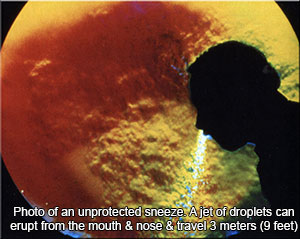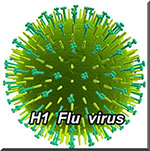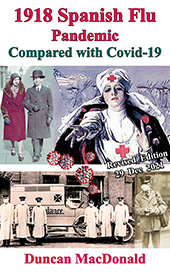Colds & Flu
Duncan MacDonald
Jakarta 9 December 2012
Revised 28 February 2018
Reviewed 18 February 2022
 The rainy season is upon us and that means more colds and flu.
The rainy season is upon us and that means more colds and flu.What is a cold and what are its causes? A cold is a highly contagious viral infection resulting in fever, runny eyes, stuffy nose, head congestion and a sore throat. It can be caused by more than two hundred viruses.
Three types of Influenza viruses affect people, called Type A, Type B, and Type C |
Multiplying rapidly, the virus create the uncomfortable symptoms of a cold while attacking the nose and throat. The battle ends when the body's immune system has wiped out the invading viruses. This normally takes between seven to ten days - unless complications such as pneumonia or bronchitis set in.
What preventive measures can be taken to guard against colds?
There is no sure fire way to prevent a cold. However the following precautions are effective:
- • avoid sharing glasses or utensils with someone who has a cold
- • be careful about shaking hands
- • avoid sneezes
- • eat a well balanced diet
- • wash your hands frequently and dry thoroughly
- • avoid touching your nose and eyes

The effects of a cold are generally restricted to the respiratory system, while influenza effects the affects the entire body.
Also unlike a cold's gradual attack, the appearance of influenza is immediate: sudden fever of at least 38°C (100.4°F), tiredness, sore throat, chills, possibly a barking cough, muscle aches and pains, sore eyes and hot damp skin.
The symptoms of influenza tend to decline after a few days, however the illness usually runs its course in a week or two. Major flu epidemics occur every ten years or so, triggered by a new strain of virus. Such epidemics affect effect 20% to 30% of people.
How serious is the flu?
For healthy children and adults, the flu is typically a moderately severe illness. Most patients
 recover within a week or two. However the flu can be very serious for older persons or those with underlying chronic illness.
recover within a week or two. However the flu can be very serious for older persons or those with underlying chronic illness. High risk persons include being over 55 or over, having chronic lung disease, diabetes, heart disease, or other chronic metabolic disorders, anaemia or undergoing any treatment that suppresses the body's immune system.
What complications can develop from the flu?
Pneumonia and congestive heart failure can result from influenza. The majority of those who die from the flu and its complications are over 65 years old. Babies born of mothers with the flu are liable to have a slightly higher rate of birth defects.
How important are flu shots? Can I catch the flu from the vaccine?
They are very important, particularly
 for those in the high risk categories. No, you cannot catch the flu from a vaccine. This is because the virus used is already dead.
for those in the high risk categories. No, you cannot catch the flu from a vaccine. This is because the virus used is already dead.
Your body however may react slightly; a mild fever within 24 hours, or a tender, red area, where the shot was administered.
In Northern and Southern parts of the world, Flu outbreaks occur mainly in winter, while in Equatorial regions, outbreaks may occur at any time. Beware of direct contact
While viruses are spread in tiny airborne droplets from coughs and sneezes, they can also be spread by direct contact. A virus can live for hours on inanimate objects such as door handles, towels or telephones.

The case of a 50 year old American who contacted SARS(Severe Acute Respiratory Syndrome) aftervisiting China in 2004 and subsequently dying in Hong Kong, is worth recalling. The ensuing explosion of world-wide cases of SARS was traced back to this individual.
The initial spread in Hong Kong was a result of people in the hotel, where the American stayed before being hospitalised, touching the lift buttons in the hotel elevator.
The virus remained alive on the lift buttons for over 8 hours. Moral of the story: When you press lift buttons, use your knuckles - not the tip of your finger. Sooner or later you will wipe your nose or eyes with that finger tip and infect yourself with any potential virus.
CONCLUSION:

Most people can expect to have between two and four colds a year. Children are more susceptible than adults because they have not yet developed immunity to the viruses that cause colds.
There is no cure for colds and flu. They are caused by viruses and cannot be treated with antibiotics.
To minimise your chances of catching a cold or the flu:
|





